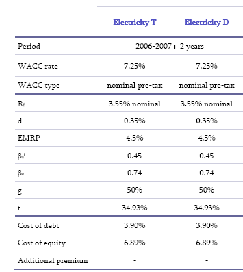Practice of corporate finance and approach of regulators
The cost of capital is generally calculated as the weighted sum of the costs of the different sources of financing used by a firm: equity and debt, in their usual distinction. The Weighted Average Cost of Capital is a fundamental element of corporate finance. Financial analysts, investors use it systematically when they seek to value and select their investments, whether it be shares or industrial projects. It thus serves as a discount rate applied to future cash flows to derive a net present value, or as a threshold value for estimating the profitability of an investment. In network industries subject to regulation, the WACC is also determined by regulators that directly affects operators' revenues. Applied to the Regulated Asset Base to obtain the capital charge, the fixed rate is a sensitive value in cost-oriented infrastructure pricing (operating and investment charges being more explicit).
The pre-tax cost of debt is usually modeled by the formula:
CD = Rf + d,
- where Rf is the risk-free rate ;
- and · d, the credit risk premium, a measure of the higher return compensating for the risk of default.
The Financial Asset Evaluation Model is most commonly used to determine the cost of after-tax equity:
CE = Rf + β.EMRP,
- where: · EMRP is the market risk premium, the additional return that shareholders expect to hold risky assets rather than risk-free assets ;
- and · beta, a measure of the firm's exposure to market or systemic risk.
Thus, given the privileged tax treatment of debt, an after-tax formulation of the cost of capital is:
WACC = (1-g).( Rf +β.EMRP)+g.(1-t) ( Rf +d),
where: g is the leverage ratio, and t, the tax rate
The issue of determining parameters
In theory, the parameters of the WACC used in corporate finance are determined in a purely forward-looking way over the duration of the investment (even if, sometimes, past developments serve as a reference for this purpose). For example, the beta calculated from market data is reduced to an economic beta stripped of the effect of debt on the company's risk profile, then "re-indebted" with a forecasted leverage. The WACC used in valuation calculations should be constantly updated based on the most recent data, such as the prevailing risk-free rate.
For regulators, concern for the stability of the rate, invariant during the regulation period, is a predominant criterion in their judgment. This allows operators to have some visibility. Regulated rates also differ in that they incorporate "normative" rather than forward-looking parameters. For example, an operator whose financial structure is clearly "sub-optimal" and destined to remain so for a certain time should not be over-remunerated as a result. It should be noted that for this g parameter, energy infrastructure regulators consider book values (as a percentage of RAB) rather than market values, as practiced in traditional corporate finance.
Compared to brokerage firms, regulators are also faced with the question of differentiating the normative WACCs according to the type of infrastructure. Beta is the parameter whose determination is, in this respect, the most delicate. But this should not lead to the choice of a value corresponding to that of the multi-activity listed group that incorporates the one being analysed, even if the reasoning on its specific risk profile relies mainly on qualitative considerations. The definition of the WACC is simple. The estimation of each of the component parameters, on the other hand, is a complex exercise as soon as one tackles it with a level of rigour proportional to the stakes. In practice, financial analysts tend to neglect this calculation to communicate essentially on the various developments likely to affect forecasted cash flows. Alternative methods, like the Arbitrage Pricing Theory which bypasses the choice of a unique financial structure in discounting cash flows, are also used. With the RAB, regulators have less latitude to adjust prices without touching the WACC. Moreover, they are now required to communicate, or even consult, more transparently on this rate, or rather these rates by asset class. But the choices are sometimes insufficiently motivated or not robust to analysis despite appearances.
Example of Achievement: Estimation of French WACCs for Gas and Electricity Infrastructures by Two Methods
At the instigation of the Energy Regulation Commission and in collaboration with PMP, Zelya conducted an original study on the WACC in two parts. The first was to carry out an "intelligent" benchmark of the rates retained by other European energy regulators. These, in essence, are of little interest when we want to compare them to the French situation. They were therefore reprocessed infrastructure by infrastructure, first to cover the same definitions (pre or post-tax rates, nominal or real) and focus on the same economic context (taxes). They were then adjusted relative to the RABs which, themselves, do not have the same scope according to the regulators. Finally, a last treatment of a more qualitative order focused on the assessment of the impact of the regulation system (price-cap, pass-through, volume risk, etc.) on the risk profile of the activity compared to the French framework. This has made it possible to compare foreign rates in a much more relevant way than with a "raw" benchmark. The second part is the more classic "internal calculation", parameter by parameter. This was based on a plurality of sources including data collected from regulators, economic literature and reprocessed market information from Bloomberg data. To differentiate the analysis by activity, a benchmark operators (beta, g) was also necessary. The comparison of results and old regulated rates thus allowed the regulator to make an informed choice of the new values to be retained.

